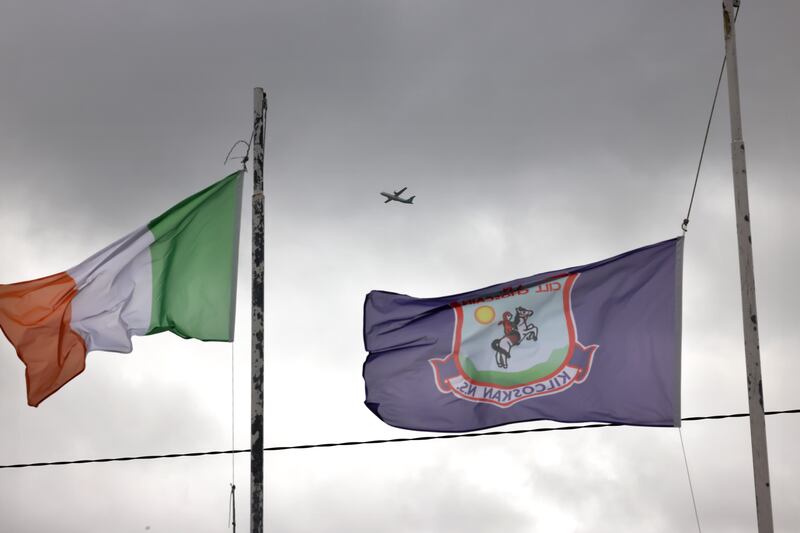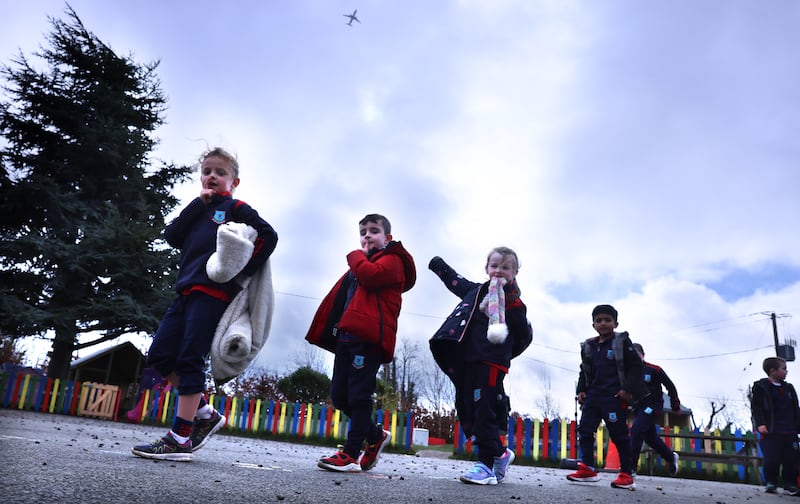Moments before a busload of children leave Kilcoskan National School in Co Dublin for their Tuesday morning swimming lesson, a large aircraft emerges from the grey bank of clouds overhead, turns sharply left and climbs into the sky. The bellow of its engines engulfs the small building underneath.
“We would be concerned that we wouldn’t have a school; I would imagine that parents would choose not to enrol their children here,” says deputy principal Trish Finnegan.
Low-flying, noisy aircraft following flight paths nobody expected have dogged northern parts of the county since Dublin Airport’s north runway began operating last August.
In recent weeks, Kilcoskan NS has attempted to stage an outdoor céilí and a harvest festival, but the children’s voices and songs were often drowned out. It is the impact on the two classes of autistic children, however, that is particularly worrying.
“They say children with autism can be bothered by the ticking of a clock,” says Finnegan. “Our main concern is the children in our [autistic] classes are predominantly non-verbal so they can’t tell us how it’s bothering them. The first impact is they spend less time outside.”
[ DAA issued with fresh warning letters by council over runway noiseOpens in new window ]
[ Dublin ‘noise maps’: How noise-polluted is your neighbourhood?Opens in new window ]
Kilcoskan has tall windows, yellow pebble-dashed walls and a concrete, pillared outdoor shelter. It opened in 1948 in the same fields and winding country roads where it stands today, not far from the community of St Margaret’s.
This time last year, staff say, they would rarely notice planes or engine noise. Now they are eagerly awaiting the outcome of an An Bord Pleanála decision affecting the north runway’s future use, and a separate planning investigation on its current use. Both could help dictate the future of Kilcoskan NS.

At a recent meeting of Fingal County Council, elected representatives questioned the perceived sluggishness of the planning decision, while DAA has categorically rejected any suggestion it is operating the runway in breach of 2007 planning conditions.
It attempted to calm the storm earlier this year by apologising to affected communities and telling them the controversial flight paths, governed by so-called Standard Instrument Departures (SIDS), would be amended in late February. For some, including Kilcoskan NS, those changes only seem to have made things worse.
Neither have they “resolved the fundamental issue which is that they are not following the plans they submitted as part of the planning permission they have been granted”, members of the St Margaret’s The Ward Residents Group told a recent closed-door session of the Oireachtas Transport Committee. They claim DAA is refusing to engage with their community.
The nature of autism is [that] a plane might really disturb somebody at 9.10am and we won’t know about it until lunchtime. They internalise things. They can’t communicate; they can’t tell us if they’re bothered by it, if they’re frightened, if they’re scared
— Deputy principal Trish Finnegan
Airport management is restricted in what it will say given the ongoing planning processes (Fingal County Council also recently defended its inability to share information for the same reason) but the community feels sidelined.
Kilcoskan NS has enjoyed a positive relationship with DAA; the company has funded outdoor classrooms and sensory equipment for its students. But, as with surrounding golf courses and private homes, the unpredictability of overflying aircraft and their long-term presence is fraying tensions.
Every few minutes, as pupils played football in the playground on Tuesday morning, aircraft rumbled through the granite sky overhead. Nearby, children played in the sensory garden, not far from a new mobile DAA noise-monitoring machine. The digital needle on a phone app bounced between 70 and 80 decibels.

“Being able to spend time outside is so, so important because we have actually designed the garden around their sensory seeking,” says Finnegan.
“The nature of autism is [that] a plane might really disturb somebody at 9.10am and we won’t know about it until lunchtime. They internalise things. They can’t communicate; they can’t tell us if they’re bothered by it, if they’re frightened, if they’re scared.”
It is a distraction, too, for the wider student body of 117 pupils. Lessons are frequently disrupted by the volume and spectacle of aircraft emerging and disappearing overhead on two different flight paths. On a bad day, the staff said flyovers would took place about every two minutes.
[ The growing menace of annoying sounds that affect our healthOpens in new window ]
“We are concerned about whether we’ll be able to open the windows in the summer,” Ms Finnegan said. “We are teaching lessons and losing kids as we go ... their heads look up and they’ll say ‘Oh, there’s another one’. And it’s in those little 30 seconds of losing their attention you could lose your whole lesson.”
Across Ireland, small rural schools are a touchstone for the health of community life. Finnegan, who grew up nearby and whose family have long ties with Kilcoskan NS, believes the north runway and its constant flights pose an existential threat.
“That would be my concern, that ultimately life in this area isn’t sustainable for their families and they might actually have to move,” she says. “The heartbreaking thing is a lot of those families are families who have had grandparents, parents come through the doors of Kilcoskan.”












